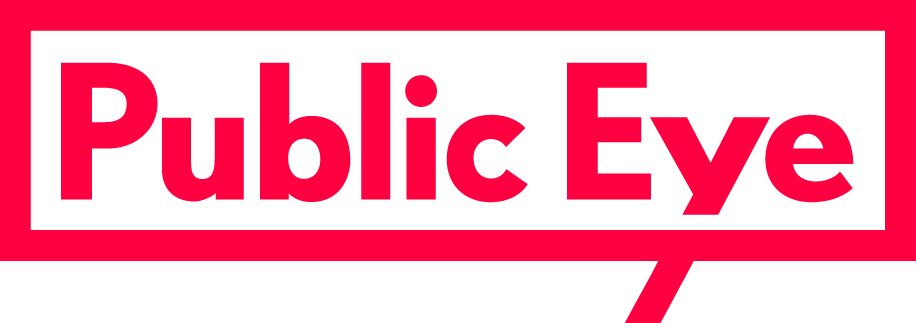Toiling away for Shein
Looking behind the shiny façade of the Chinese “ultra-fast fashion” giant
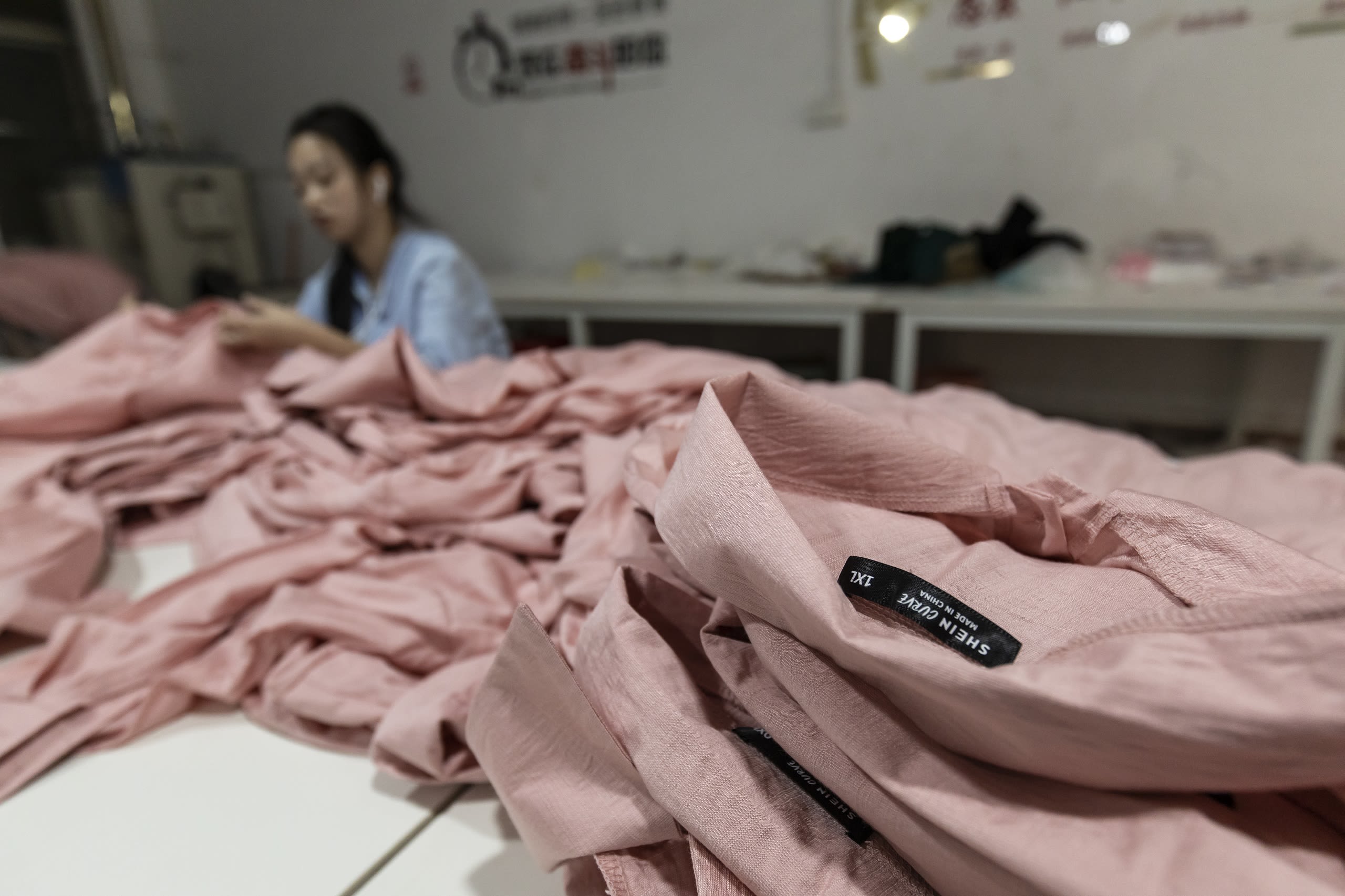
Arriving like a rocket from China! With a huge range of unashamedly cheap items of clothing and an aggressive social media presence, online clothing retailer Shein (pronounced “she-in”) is catching up with industry giants like H&M and Zara in the race for young women’s money and attention. Despite its glitzy online presence, the company behind the brand remains opaque. Public Eye took on the task of shedding light on its darker side – right up to the winding alleys of the southern Chinese metropolis of Guangzhou, where thousands of Chinese workers spend up to 12 hours a day sewing together fabrics to make teen dreams come true.
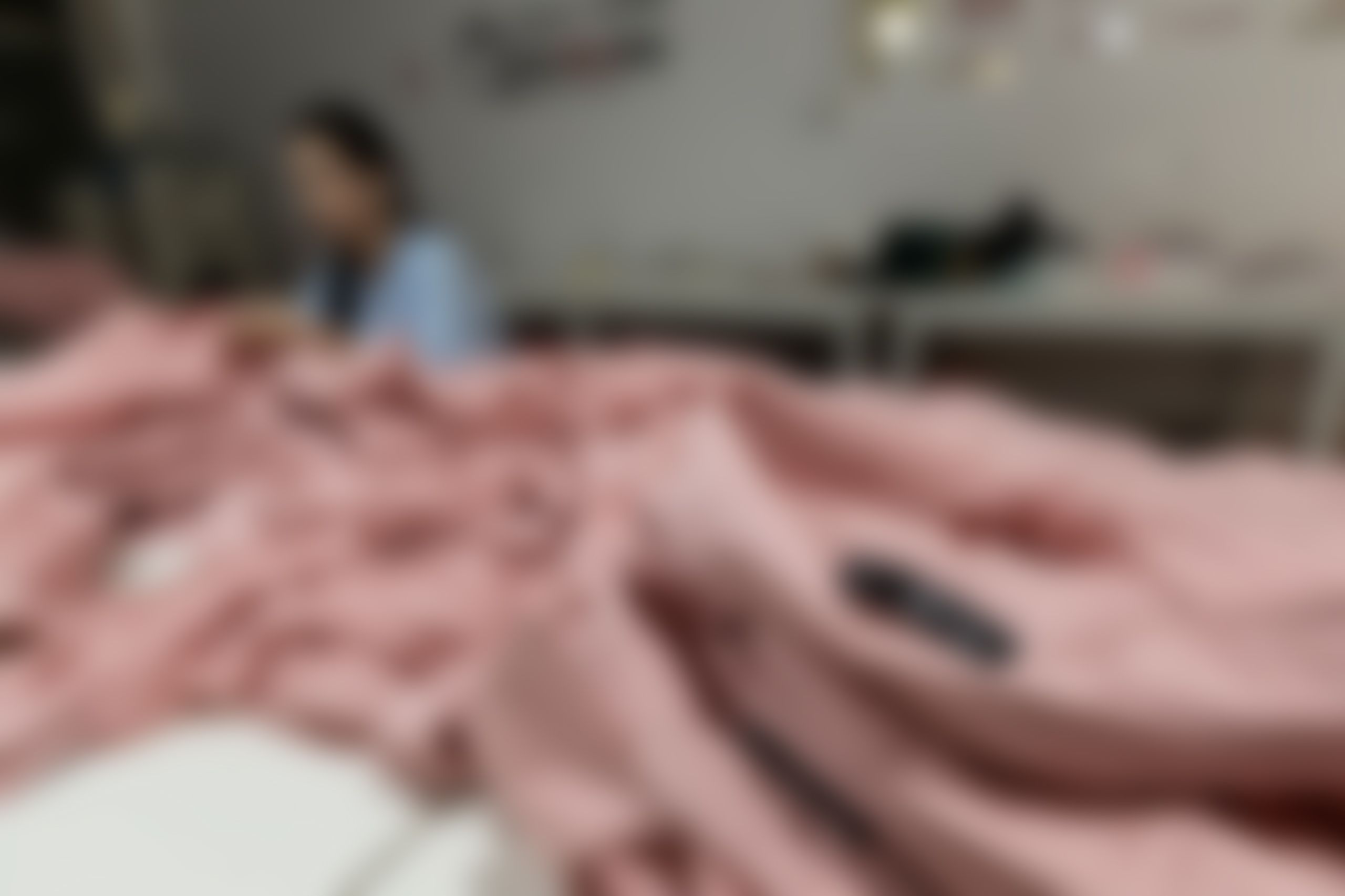

Willie Gomez is thrilled! The Caribbean pop singer loves “… that Shein is putting together a show like this. Really supporting all ethnicities, all shapes and sizes – you know – it’s so inclusive.” Cut! We’re now backstage. “I’m ready” says Willie from behind his face-mask. “Let’s do this.”
Another cut! Willie gets out of a Cadillac and prepares to start performing a lively Latino tear-jerker. He is accompanied by a swiftly alternating troupe of extravagantly dressed dancers, carefully selected on the basis of diversity – tall or short, chubby or thin, with a range of origins and skin colours.
After Willie Gomez, it’s Blu DeTiger’s turn. The singer and bass guitarist from New York declares: “there’s no one else that I know of that sings and plays bass” (she’s obviously too young to know about Sting!) and considers that Shein is “really revolutionizing what a fashion show could be”. The dance-floor is marked out by colourful neon lights. Apart from this, everything is black except the huge white Shein logo on the floor. There is no audience. This place could be anywhere – or just as easily, nowhere.
“The vibrance of fashion, the energy of music, and the power of dance are a united fabric,” states the introduction to the “Shein X Rock the Runway” showcase that was broadcast live on YouTube, Instagram and Shein’s app in late September.
In the following days, customers could order from a range of 6,000 different items of clothing in the #SHEINXRockTheRunway section of their website, but the menu icon suddenly disappeared ten days after the broadcast.
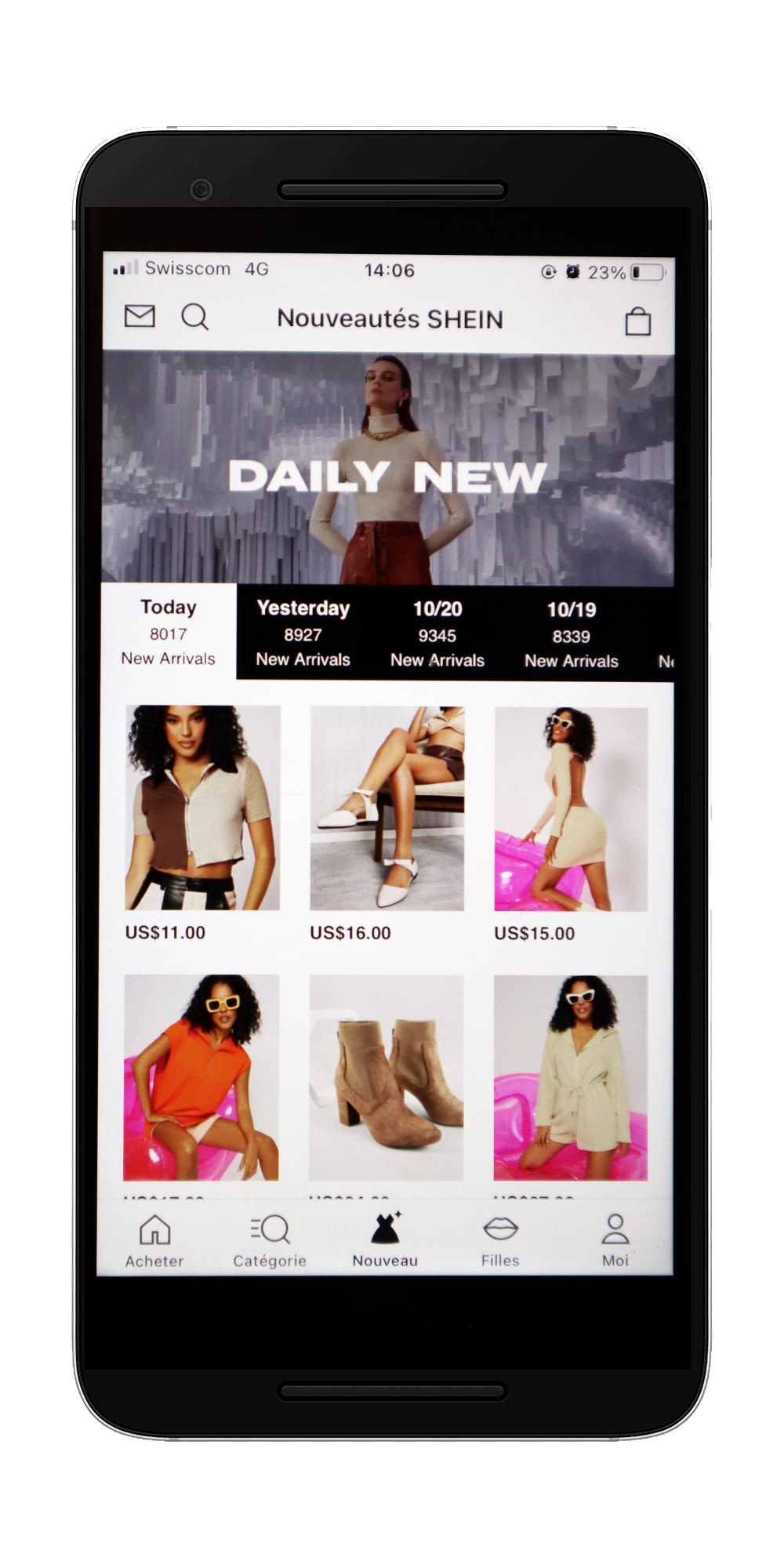
“DAILY NEW”: 8,017 new products were placed in the shop that day.
Yet the range of options certainly remained varied. On one Wednesday afternoon in early October, there were 259,264 products in the “Woman Clothing” category, over 78,000 in the plus-size section, and around 32,000 in “Men Clothing”. Clothes can be filtered using a “Daily New” tab.
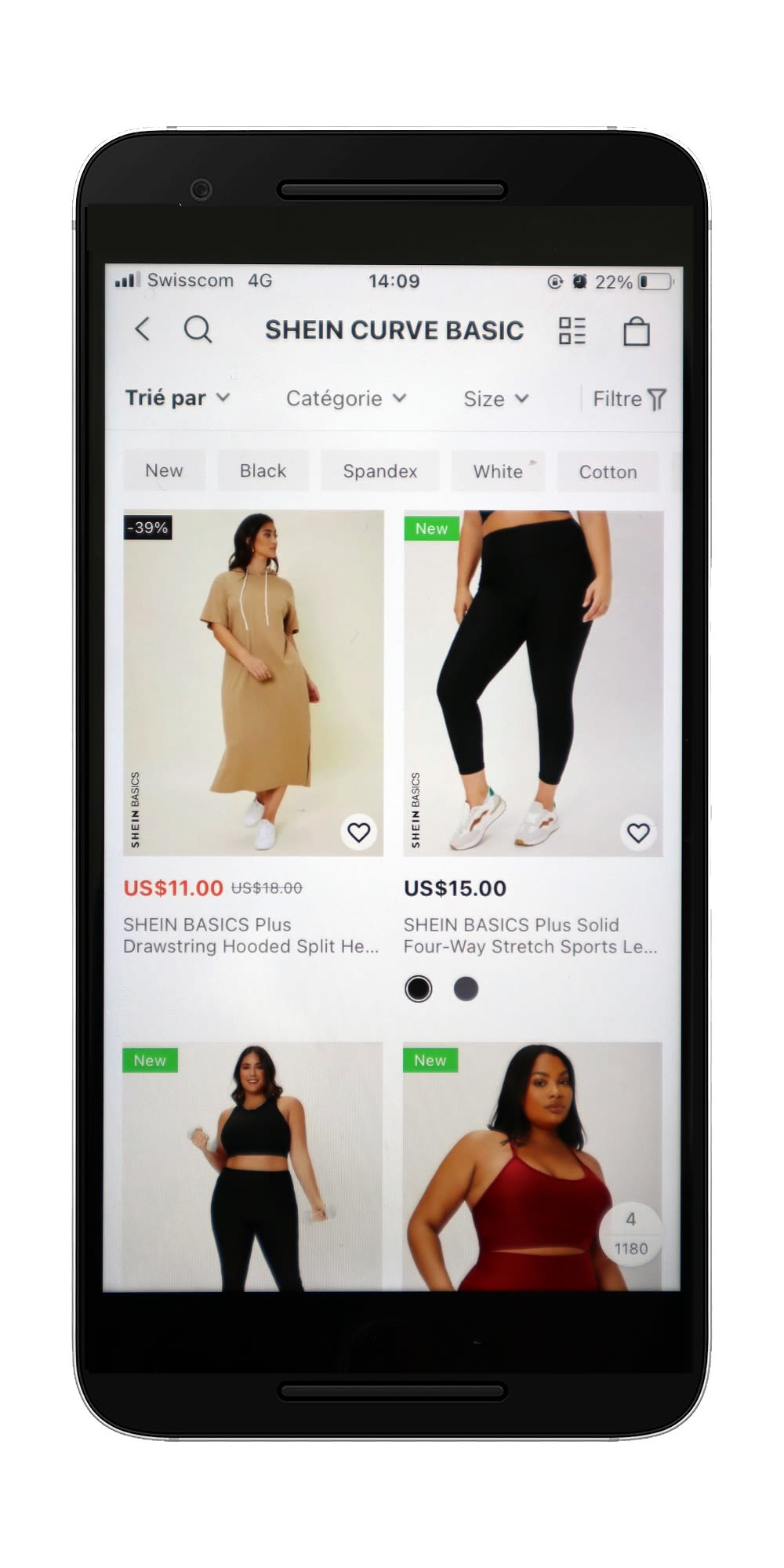
“PLUS SIZE”: Ten thousand items of clothing between XL and 4XL.
A total of 6,753 products were added on that day, many of them modelled by curvy women with pouting lips and narrow waists and often striking raunchy poses, some of which bordered on vulgar. A zebra-striped halter top costs CHF 8 (USD 8.75), and a denim jacket with puff sleeves CHF 22. The most expensive item of clothing that was added to the selection that day, a snakeskin trench coat, costs CHF 65. Two-thirds of the new additions are priced below CHF 20.
How did we end up here? Who is Shein?
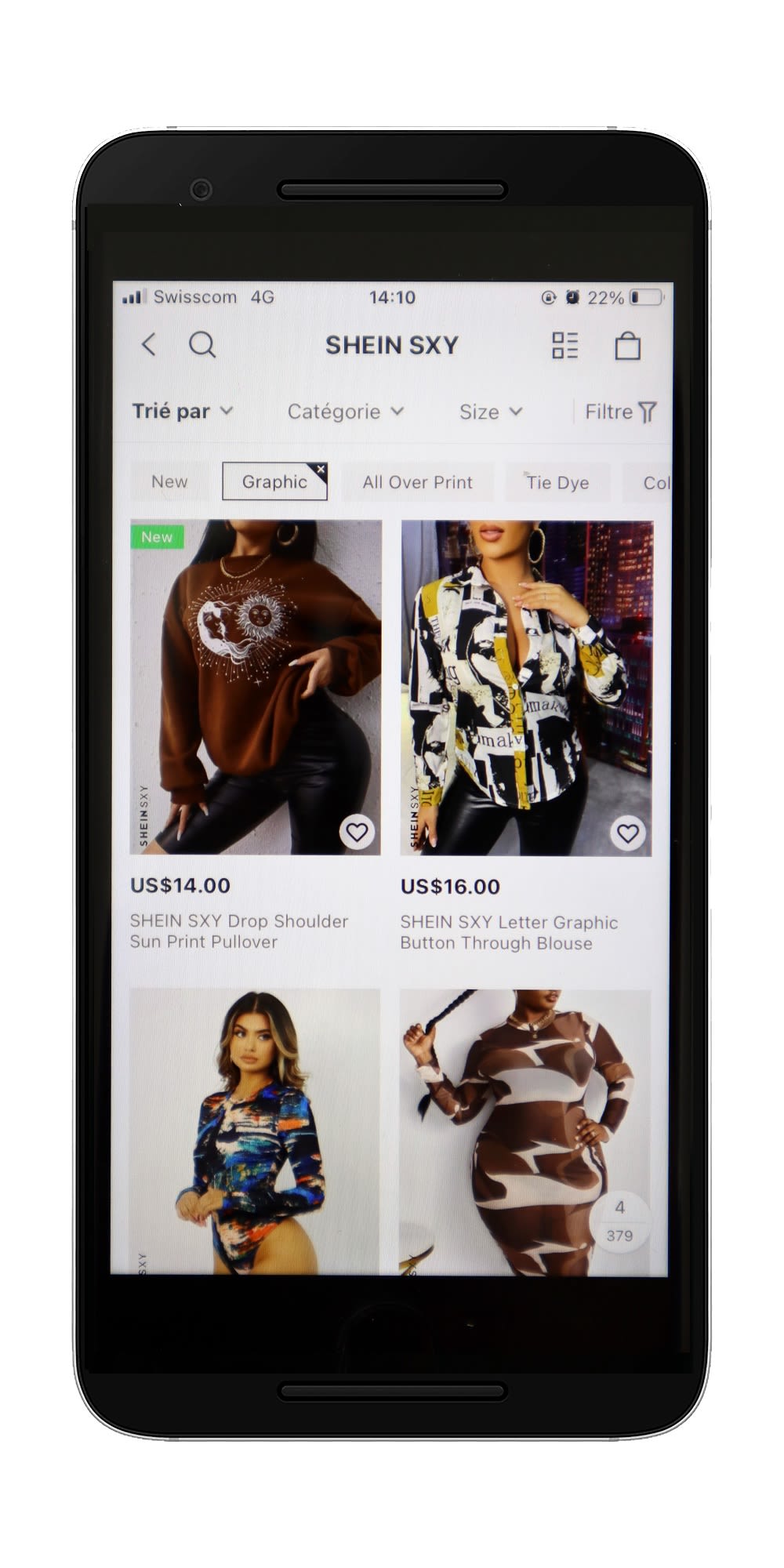
“SXY” is its own category within Shein.
Who is Shein? Many people asked themselves this question for the first time in May this year, when it was reported that the Shein app had overtaken the Amazon app as the most frequently downloaded shopping app in the United States.
In a short time, by and large completely unnoticed by those over the age of 30, the company has grown into a giant of the online clothing industry. This is evident from the number of followers it has on social media. As of early October, it had 22 million followers on Instagram, 23 million on Facebook (approximately half as many as H&M and Zara), and 2.8 million on TikTok (many times over that of its two competitors).

“DAILY NEW”: 8,017 new products were placed in the shop that day.
“DAILY NEW”: 8,017 new products were placed in the shop that day.

“PLUS SIZE”: Ten thousand items of clothing between XL and 4XL.
“PLUS SIZE”: Ten thousand items of clothing between XL and 4XL.

“SXY” is its own category within Shein.
“SXY” is its own category within Shein.
The company
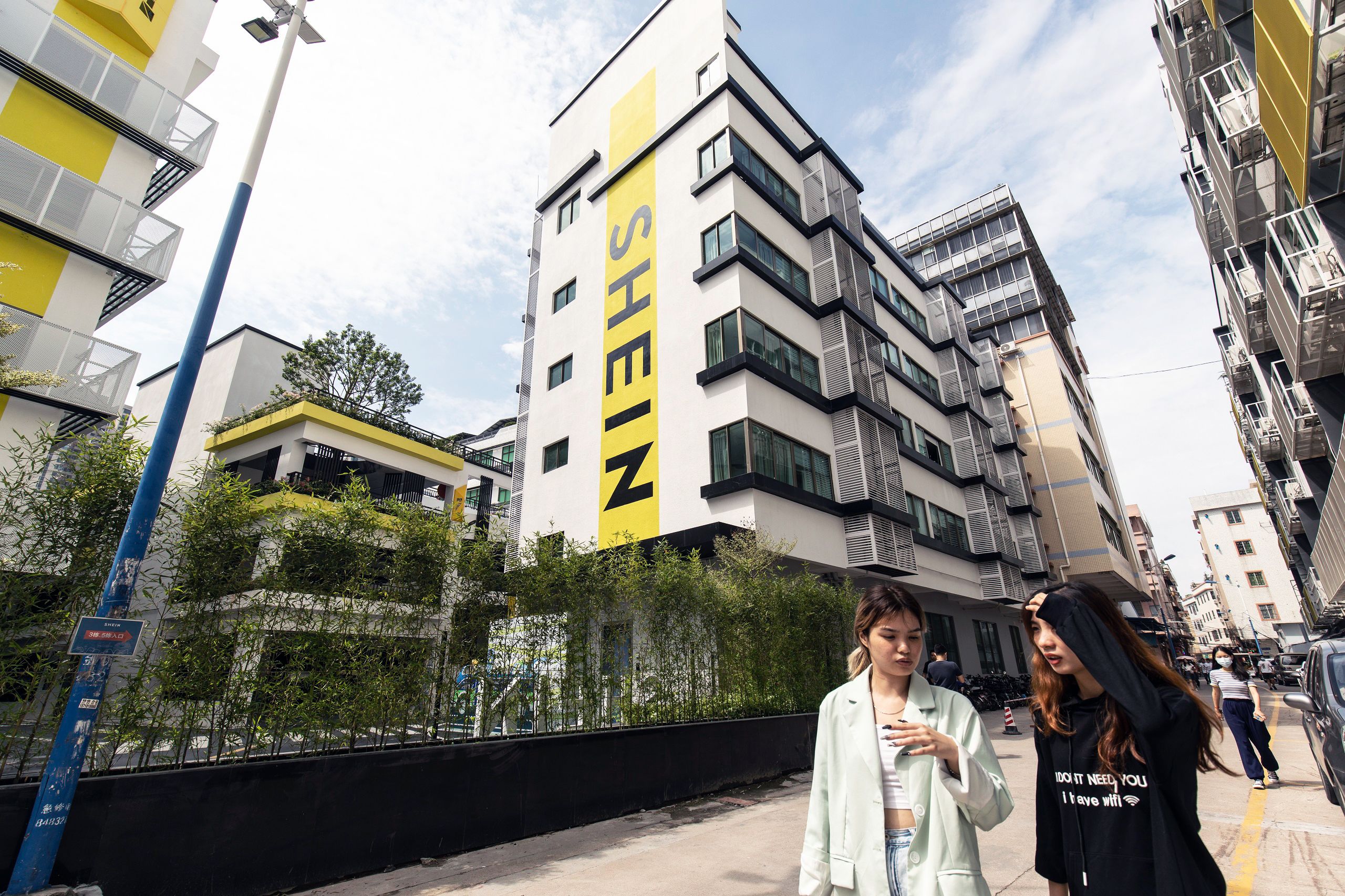
“Shein Hauls” have become an art form – young people (mostly women) unpack their deliveries, try the clothes on and comment on how they feel in front of the camera. Some of these videos on YouTube have been viewed several million times, and TikTok posts with the hashtag #sheinhaul have a total of 3.7 billion views. That means just one thing: orders are being placed at a crazy rate!
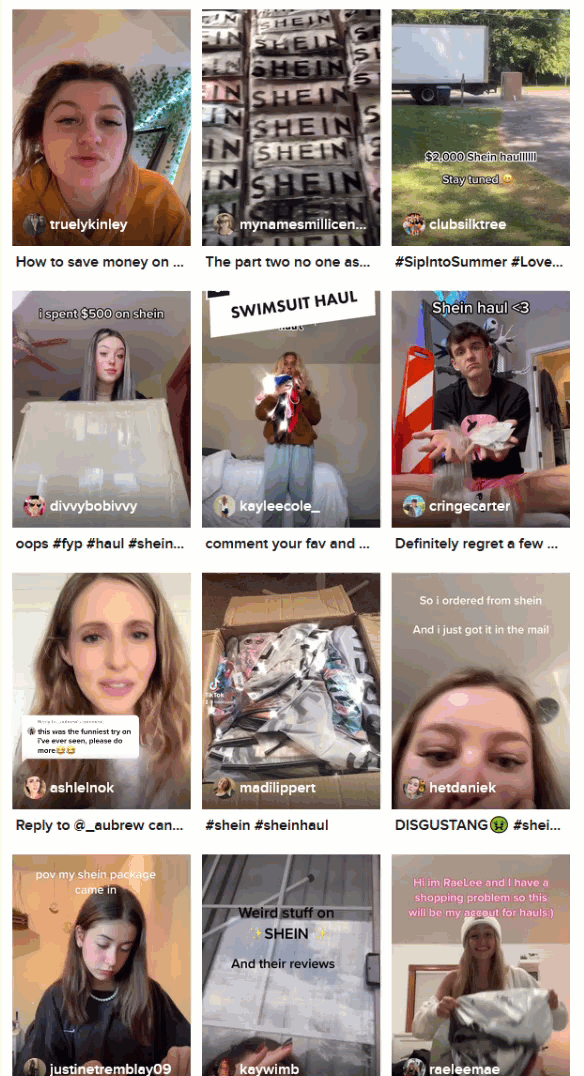
There are thousands of videos under the hashtag #Sheinhaul, for example on the TikTok app.
There are thousands of videos under the hashtag #Sheinhaul, for example on the TikTok app.
Shein does not disclose any information on its revenues. According to a Chinese report from December 2020, which has since been cited repeatedly, that year the company made nearly USD 10 billion. A large Chinese broker forecasts revenues of USD 20 billion for 2021.
The Shein website provides little information about the company. It states that Shein is “an international B2C fast fashion e-commerce company”. B2C (short for Business-to-Consumer) describes the direct business relationship between a company and the end-consumer. According to the website, Shein’s main markets are “Europe, America, Australia, and the Middle East, along with other consumer markets”; in total it maintains that it is present “in over 150 countries and regions”. It does not state the location from which the clothes are distributed. Only the address of the parent company is provided in the imprint of the Swiss website – it’s called Zoetop Business and is headquartered in Hong Kong (what we found out about their corporate structure).
The recipe for success
In a nutshell, what we can say about Shein on the basis of a few comprehensive analyses in related portals is that the predecessor company was founded by three men in 2008 in the eastern Chinese city of Nanjing. The founders of the company that originally sold mostly wedding dresses included Xu Yangtian, a specialist in search engine optimization. In 2012 – by then without his former colleagues – he started distributing women’s fashion under the domain name sheinside.com. The business really took off in 2015.
Key success factors include:
- direct delivery instead of maintaining expensive stores
- the intensive use of online tools to identify trends
- an automated analysis of purchases and movements within the app
- relying on influencers in a big way
- a dense network of mostly small suppliers in the South Chinese city of Guangzhou, where Shein transferred its headquarters in 2017.
All of these suppliers are incorporated in the company’s own software, and therefore orders can be distributed among them automatically. This enables Shein to respond to trends unusually quickly.
With its production cycle of three to four weeks, Zara had until now been the byword for fast fashion. Shein is supposedly able to produce an item of clothing within a week – from design to packaging.
Shein hasn’t always been able to keep up with its rapid rise. In 2018, it came to light that the usernames and passwords of over 6 million customers had been stolen in a cyber attack. In July 2020, the company hit the headlines twice in one week: firstly, because it had sold a Muslim prayer rug as a “Greek carpet” and then – only just after it had apologized – because it put a gold chain with a swastika pendant on its site. Shein has been repeatedly accused of manipulating online reviews, and in numerous cases designers have been able to prove that Shein stole their designs.
Yet none of these scandals affected Shein’s rapid, steady rise – or the fact that it remained a mystery.
One of the most important questions about which the public still has no information is where and under what conditions the low-cost brand’s articles of clothing are produced.
The research
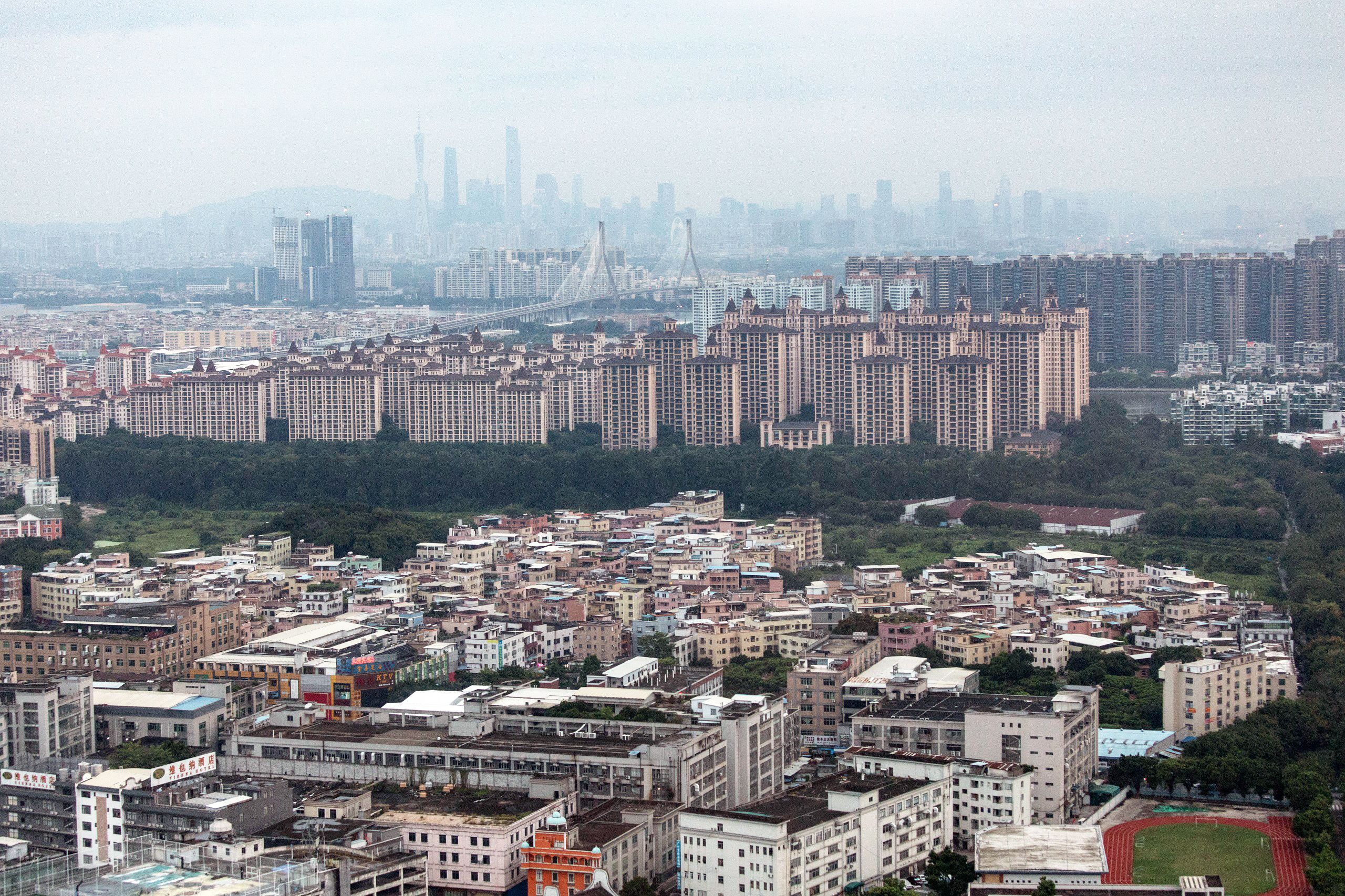
In late 2020, Public Eye set itself the task of answering that very question. We contacted an organization that defends workers’ rights in South China (its name cannot be disclosed for security reasons). In April, two researchers started to seek out Shein’s suppliers in Guangzhou – a metropolis in the Pearl River Delta, located some 100 km north of Hong Kong.
In the subsequent weeks, they managed to locate a total of 17 companies that supply Shein. Seven of them are located in Nancun, a neighbourhood in the district of Panyu. In July, a researcher was able to interview three female and seven male workers in the area. They earn a living in six different companies – operating sewing and quilting machines, working in the quality control and packaging departments, or ironing or cutting fabric. They all originally come from the provinces and have years or decades of experience in the industry. Most have been working for their current employers for less than a year.
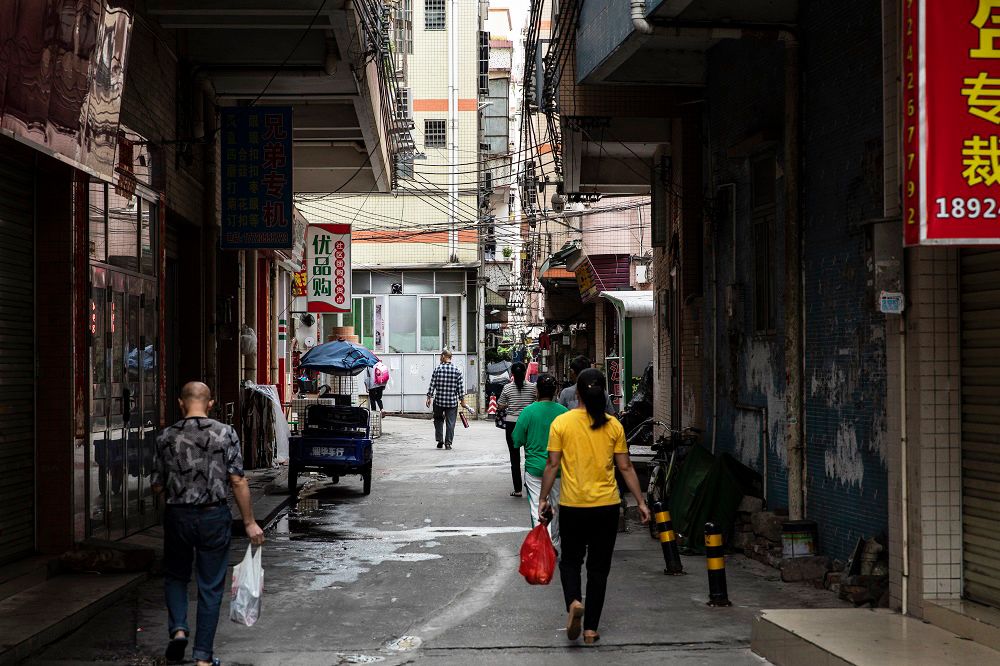
The streets of Panyu, a municipality of the 16-million metropolis Guangzhou.
The streets of Panyu, a municipality of the 16-million metropolis Guangzhou.
We obtained the findings of the research and statements of interviewees in writing, in the form of detailed reports illustrated with mobile-phone pictures. They depict factory corridors covered in bags, workers at standing tables, stacks of T-shirts packed in plastic “Shein” bags, and workstations lit by neon lights.
We don’t know what our researcher looks like: she keeps her camera switched off when she reported on her findings via video call. The risk of being caught by the radar of the Chinese surveillance apparatus is too great.
What we can say about her is that she has now been active as a researcher, activist and trainer for industry employees for approximately 20 years. She has in-depth knowledge of the textile sector in the region, though she had never heard of a brand called Shein until we asked about it.
Safety deficiencies in “Shein Village”
We follow her to Nancun Village; the place where the original village of Nancun was built. Several dozen workshops are located within just a few streets, most of them set up in former residential buildings. The researcher was told by a factory owner that the village produces clothing almost “exclusively” for Shein. She says that this surprised her, because such small, informal production sites would usually supply local brands. International companies generally prefer larger, better regulated companies.
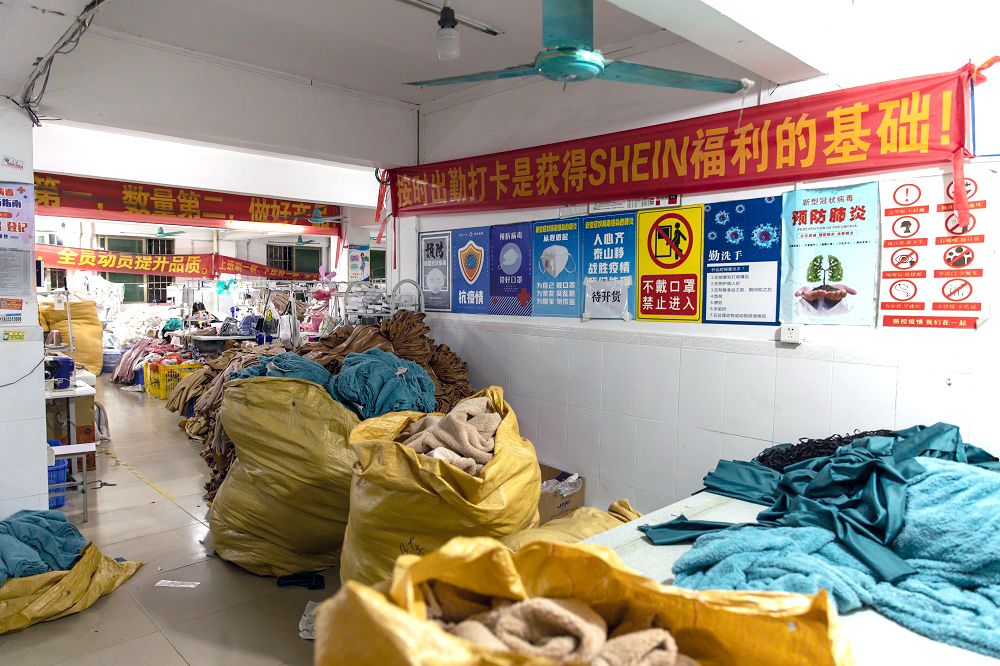
No way out in case of fire – bags block the corridors…
No way out in case of fire – bags block the corridors…
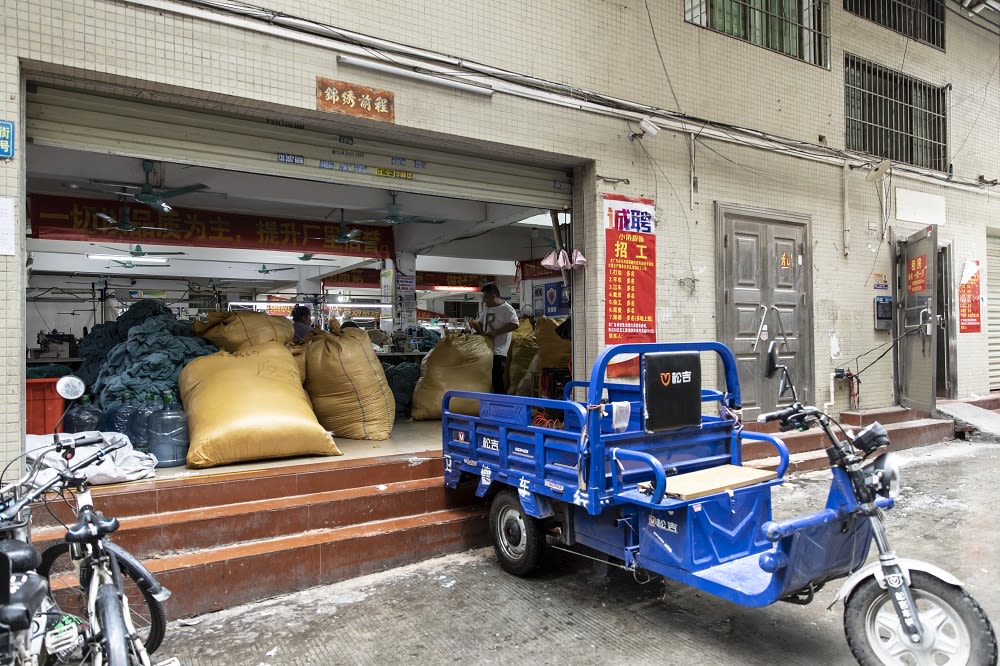
…and the exit at a Shein supplier in Nancun Village.
…and the exit at a Shein supplier in Nancun Village.
It’s just as narrow in the production sites as it is in the small winding streets of this sprawling neighbourhood. Bags of clothes and rolls of fabric block corridors and stairways. This is not only the case in the numerous small workshops, but also in some of the several larger companies located in “Shein Village”; for example, in the company that according to employees owns seven workshops in which over 200 people work. On a poster pinned to the wall, it indicates that the company is a “main supplier to Zoetop”, Shein’s parent company, and produces 1.2 million articles of clothing a day.
In the discussion, the researcher reports that she didn’t see a single emergency exit, and that the entrances and stairs don’t allow workers to leave the premises quickly. Moreover, the windows in the upper floor are barred. “I don’t want to think about what would happen if a fire broke out there”, she concludes.
In September, Shein published a Supplier Code of Conduct on its website for the first time. It specifies, among other things, that “supplier partners shall provide a safe, hygienic and healthy workplace environment”. Clearly there is still much work to do in this regard.
Two full-time jobs in one
In one of the seven companies, the researcher was able to hold a long interview with one female and two male workers. The first point that stands out when you read the interview protocols is how many hours the three employees work. They all give similar working times: from 8 a.m. to 12 p.m. in the morning; then from 1.30 p.m. to 5.45 p.m.; and then in the evening from 7 p.m. to 10 or 10.30 p.m. They work after dinner every day of the week except one, with one day off per month.
That amounts to over 75 working hours per week.
This not only contravenes the requirement in Shein’s Supplier Code of Conduct for suppliers to “arrange working hours reasonably” – it’s also illegal on numerous counts. According to Chinese labour law, a working week can comprise a maximum of 40 hours, overtime cannot exceed 36 hours per month, and workers must have at least one day off per week.
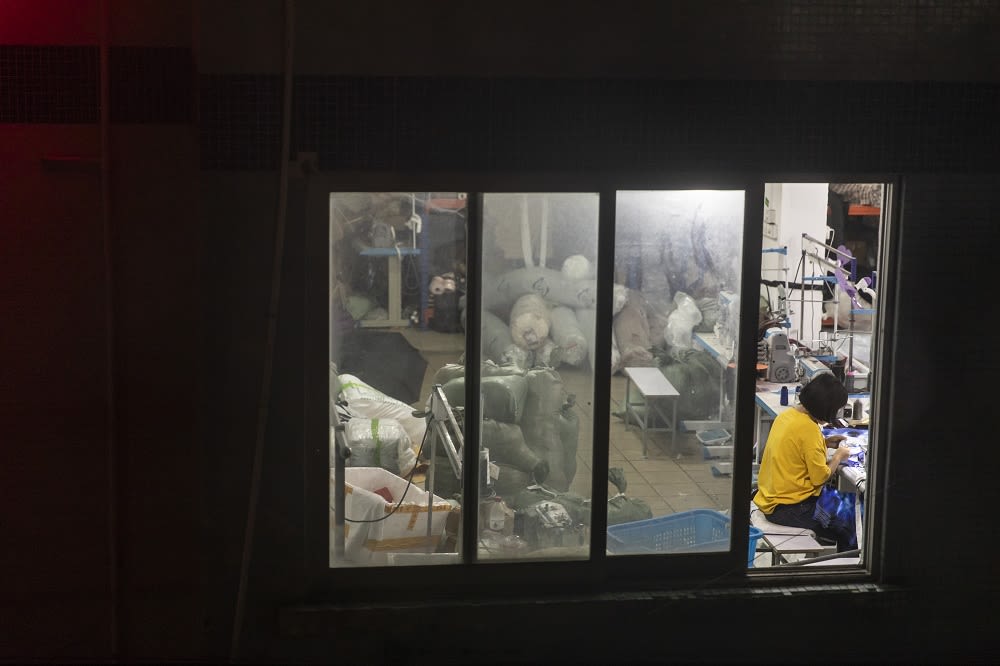
Seamstresses work on average 11.5 hours a day.
Seamstresses work on average 11.5 hours a day.
The researcher tells us that such working hours are not unusual in the textile industry, and that many workers want to work these hours. For they are all “migrant workers”, i.e. women and men from the provinces, where wages are significantly lower. Many are only in the city for a limited time, without their families and with no responsibilities other than to earn as much money as possible. “You might find a local in the office of a company” notes the researcher, “but in the production departments there are only migrant workers”.
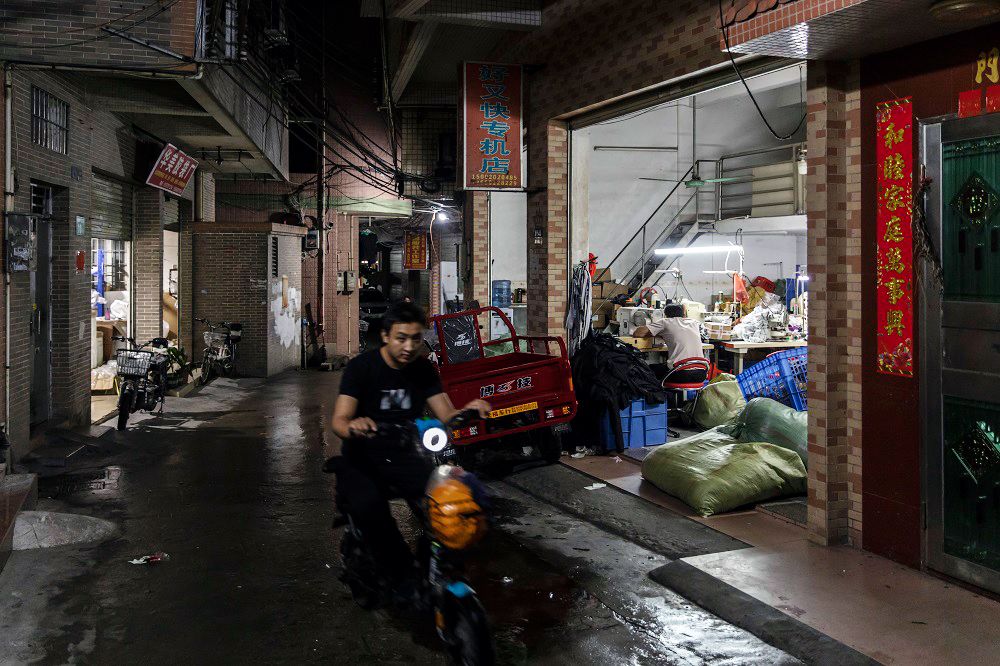
A typical working day ends at 10.30pm.
A typical working day ends at 10.30pm.
If they are prepared to effectively work two jobs in one, they can earn relatively good money. All three interviewees state on the record that they are paid per item of clothing – the more complicated the item, the higher the amount. One of the interviewees states that, in general, the wage per item of clothing is considerably lower here than in other places where he had worked. However, the quality expectations are not particularly high either.
In a good month, he earns up to 10,000 yuan or approximately CHF 1,400 to take home; in bad months it can be only a third of that. There is no overtime premium.
Another point that stands out is that all three employees reported that they had not signed an employment contract. “Factories like these do not have to issue contracts”, or so the workers believe.
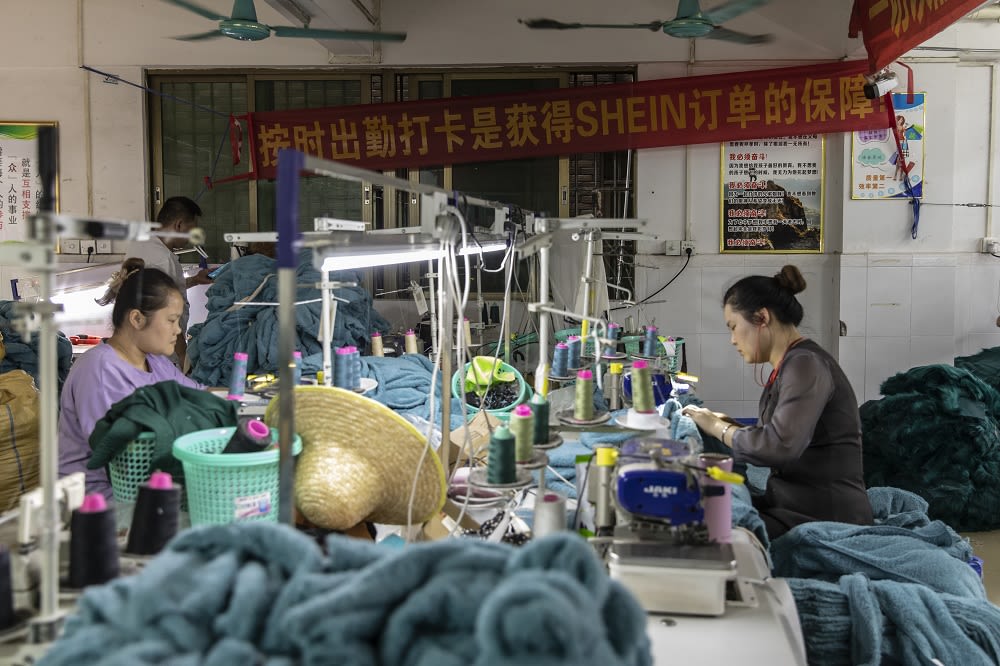
None of the ten employees interviewed had signed an employment contract.
None of the ten employees interviewed had signed an employment contract.
The researcher stated that it’s not surprising that in small, informal workshops there are no contracts. However, she was astonished that companies with over 100 employees did not issue contracts either. Chinese labour law requires them to do so and to provide employees with a copy. The researcher stated that companies of this size generally do not run the risk of being obliged to pay significant compensation payments if they are sued for failing to issue contracts.
Highly automated and hyper-flexible
There are numerous posts from Shein on the Chinese platform WeChat, where the company publishes production requirements that manufacturers can tender for. The manufacturing companies then purchase the fabric for the desired design themselves, once again from suppliers that Shein refers them to. This enables the company to control the entire supply chain without having to accept responsibility for the working conditions.
We don’t know whether Shein performs any kind of inspections in these companies. In a statement on its U.S. website, the company claims to invest “substantial efforts and resources” in its audit system. Shein states that in the past it conducted audits, with notice, and that it will be conducting additional internal audits, with and without notice, of manufacturing partners and finished product vendors. However, none of the ten employees who our researcher spoke to was aware of any audits having taken place.
In the larger factories there are posters on the walls that remind employees to clock in and out of work. We learn that the factory management shares the data with Shein, and that the company then issues contracts according to the factories workforce. This computer-supported, highly flexible supplier system appears to enable the hundreds of small production companies to be organized efficiently.
Most Shein orders are for only one or two hundred items, sometimes even fewer.
If a product sells well, Shein orders additional batches, usually from the supplier that manufactured the initial order.
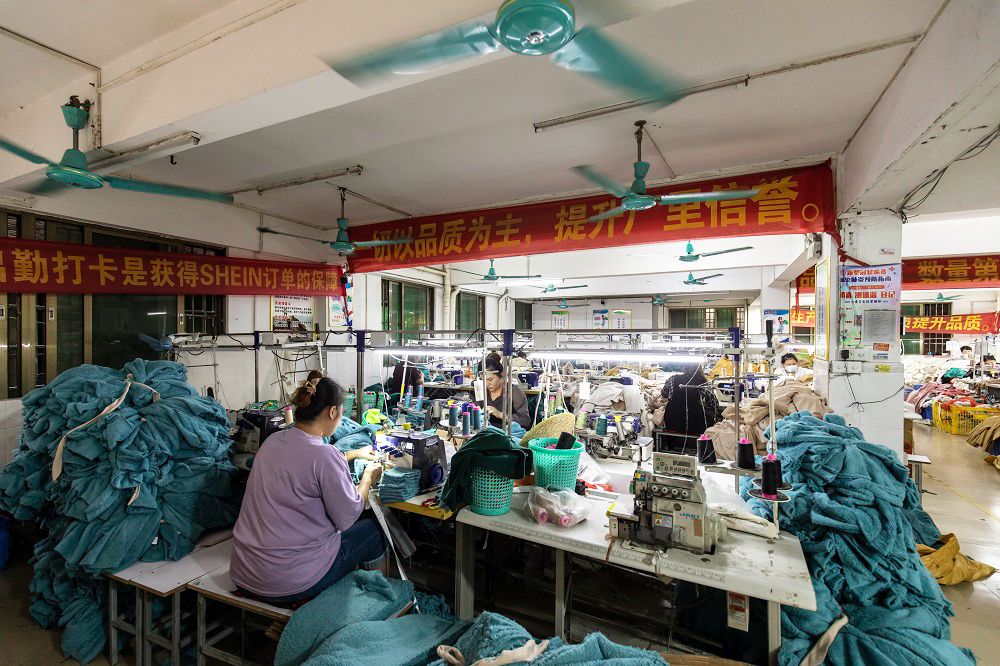
A poster at a supplier firm states “clocking in and out secures Shein orders”. Shein always knows how many workers are present.
A poster at a supplier firm states “clocking in and out secures Shein orders”. Shein always knows how many workers are present.
This pleases the employees, who can produce an item of clothing that they are already familiar with, and can therefore complete the task more quickly, meaning that they ultimately earn more money. One of the most tiring things about working for Shein is that employees have to constantly get used to new cutting patterns, complicating the work of a cutter interviewed at one of the factories.
High expectations
The small quantities and the need for items to be produced very quickly make division of labour difficult. Seamstresses in factories have to be able to complete many different tasks on constantly changing patterns. This also explains why, in these factories, you mostly meet women and men who have years or decades of experience in the industry. Inexperienced workers simply wouldn’t be up to the task.
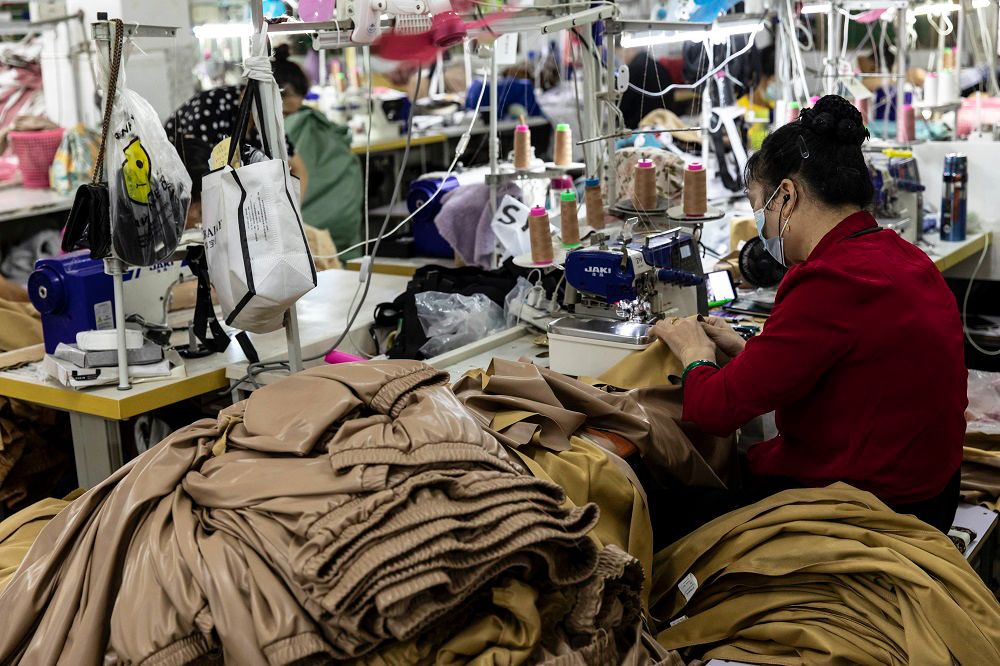
Few items, big challenge – most Shein orders are comprised of less than 200 items.
Few items, big challenge – most Shein orders are comprised of less than 200 items.
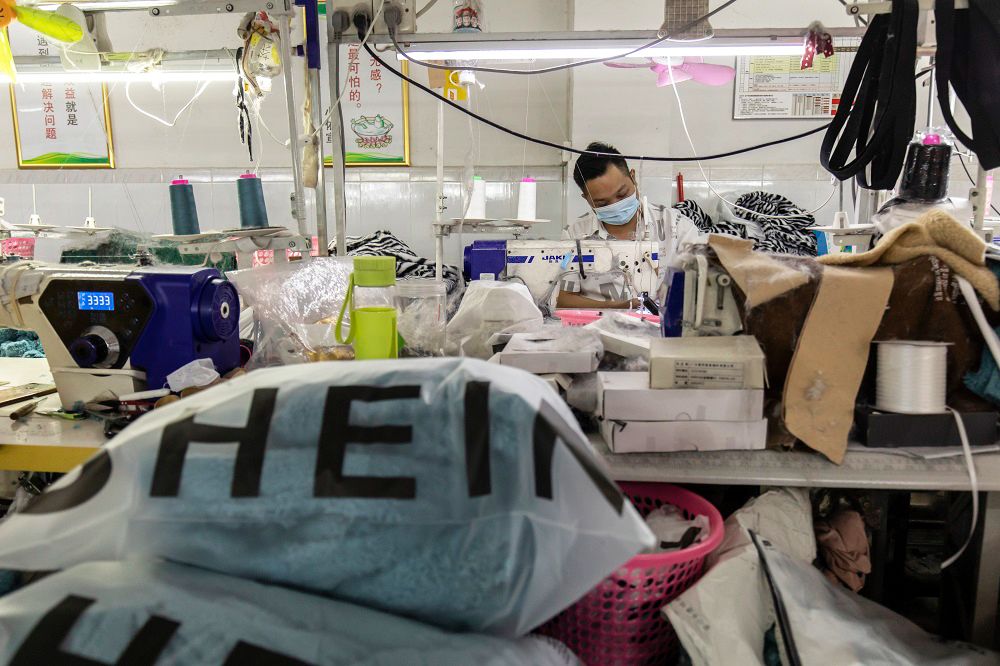
As a result, workers must constantly get to grips with new patterns.
As a result, workers must constantly get to grips with new patterns.
On the other hand, experts on the ground say that workers who are able to make relatively easy items of clothing quickly are unlikely to find many other jobs in the precarious Chinese textile industry, where they could earn more. The researcher reports that most of the workers she had spoken to were more or less satisfied with their job, “but I don’t believe they think about it all that much”.
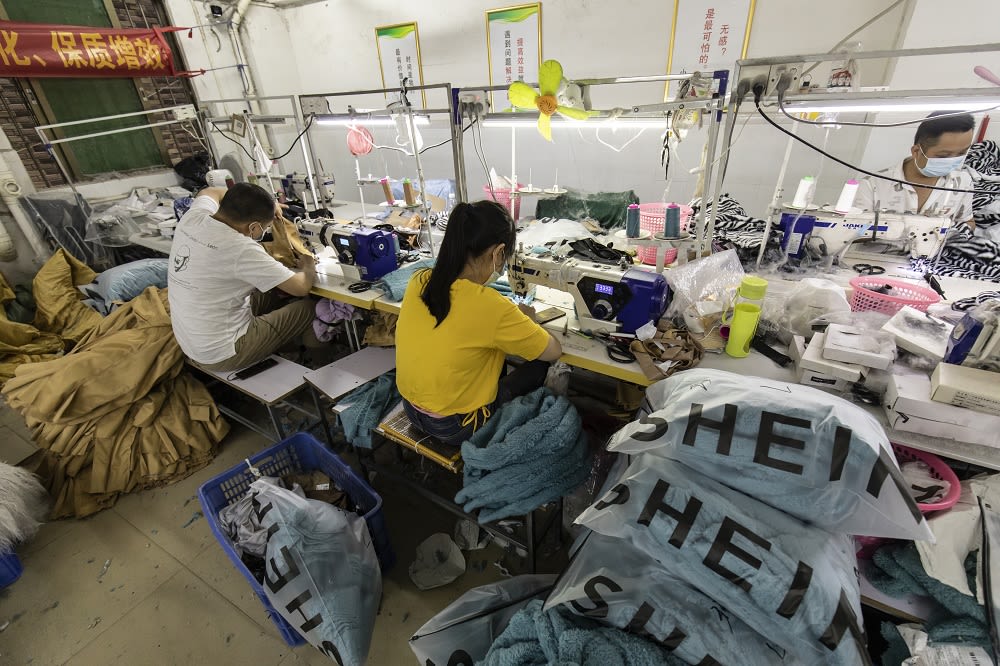
Only experienced seamstresses are able to meet the demanding requirements.
Only experienced seamstresses are able to meet the demanding requirements.
According to Chinese media reports, in the municipality of Panyu, Shein relies not only on a network of 300-400 “main suppliers” but also on approximately 1,000 sub-contractors to whom orders are passed on. The carts used to transport textiles that are parked outside some factories are a clear sign of the lively subcontracting business. Many of the small companies here in Nancun Village only undertake the final touches – cutting the last threads, ironing, packaging and loading. However, there are no calls for tender for final assembly on the WeChat platform. So it’s fairly clear that these companies work as sub-contractors for Shein suppliers – and that in the event of an accident or outstanding wage payments, Shein would certainly not feel responsible.
No contract, no insurance
The Hongui Properties Building, a building full of textile workshops, is located half an hour’s walk west of Shein Village. Everything here is slightly more regulated – the corridors are wider, and the emergency exits are signposted. The factories here have up to 200 employees. The researcher is able to interview one female and one male employee from two different companies, and their reports are similar to the ones from Nancun Village.
The employees are paid per item; there is neither a basic wage nor an overtime premium; they work 11 hours a day and have one or two free days a month.
They don’t have employment contracts. Although contributions from both employers and employees are a legal requirement, none of the latter are entitled to social security benefits.
The employees interviewed are far more concerned about the recent and ongoing reductions to the piece rates and about the fact that, at the same time, increasingly only complicated pieces are being produced at the location. Simple jobs were increasingly being outsourced to other provinces, they say – to Jiangxi, Guangxi or Hunan, where wages are lower. In fact, a minivan stands next to the building with the names of various municipalities in the province of Jiangxi written on its side. It‘s a kind of “taxi” for pre-cut pieces of fabric that are due to be produced in the interior of the country – we don’t know under what conditions or at what wage-rates.
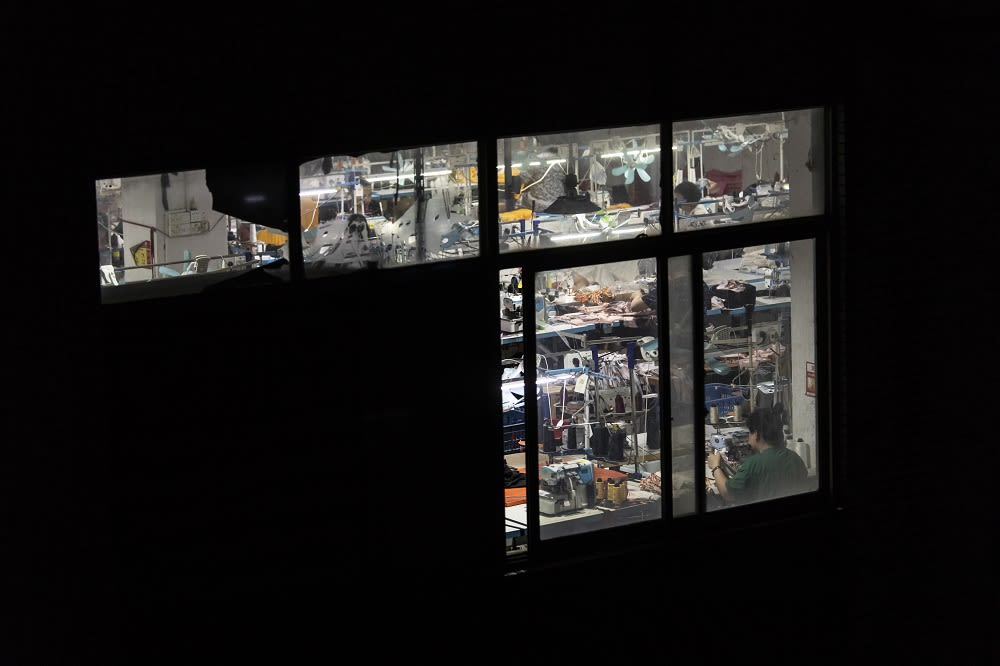
Honghui Properties Building at night.
Honghui Properties Building at night.
We follow our researcher once again, a few kilometres to the West where numerous additional textile factories are located. These factories are generally slightly larger and have up to 300 employees. They usually have reasonably well-functioning ventilation systems and slightly larger workspaces, and there are employee canteens and accommodation in the vicinity. The five employees of larger companies with whom the researcher speaks describe similar working conditions to those already noted: 11 hours a day, no employment contract, and no social security contributions.
In one of the companies, we encounter something that we have not seen elsewhere – a guaranteed minimum income. A recruitment poster at the factory entrance states the minimum incomes for specific tasks: cutting threads: 4,000 yuan; packaging: 5,000 yuan; ironing: 7,000 yuan. The pay difference for ironing is explained by the fact that the workers iron the clothes in constant heat, due to the steam, and can seldom sit down.
The Delivery
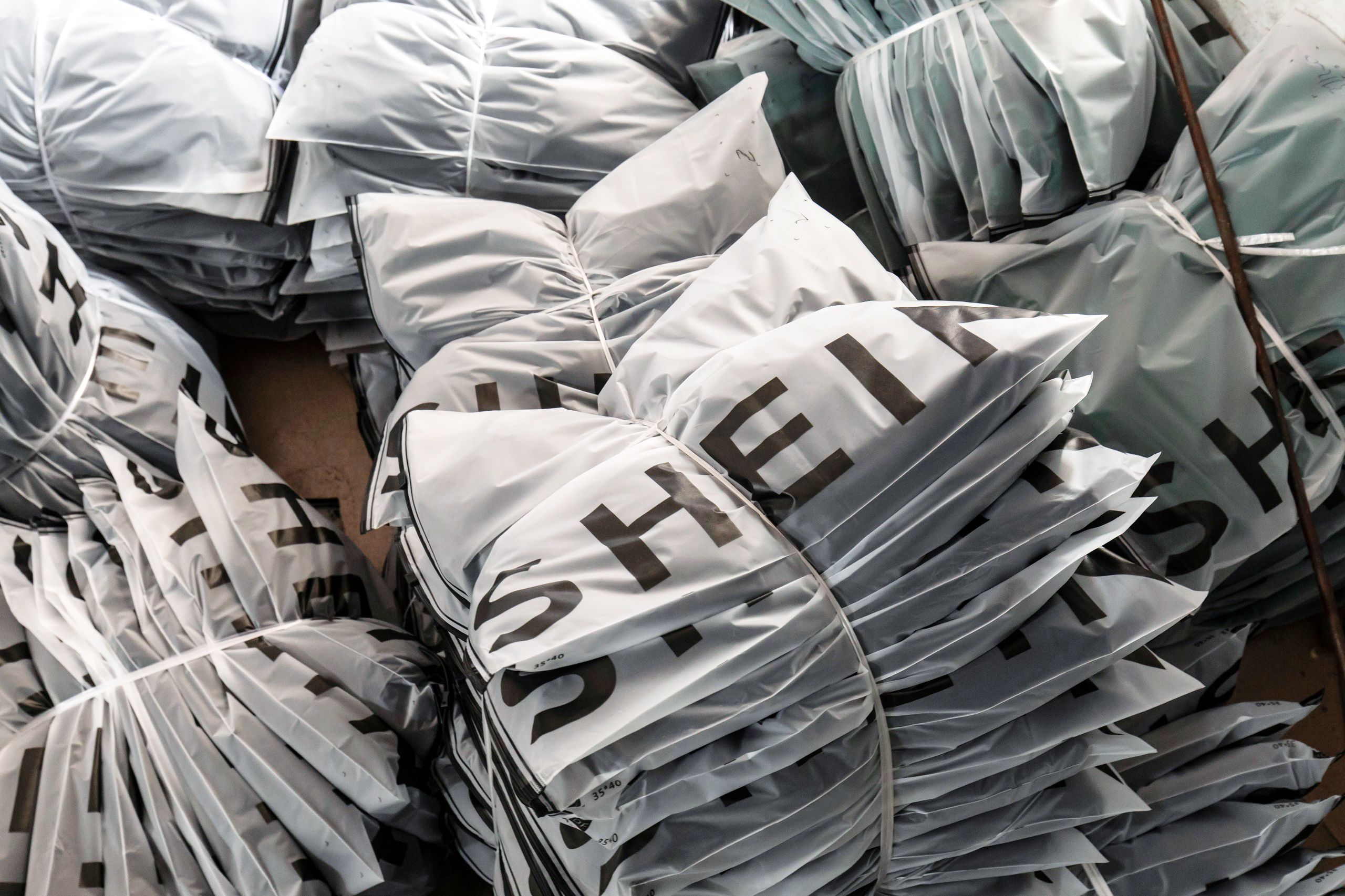
In the factory hall, the researcher is able to view a snapshot of a girl’s dress. It’s a simple item – blue flowers printed on white polyester. The research estimates that, for a dress like this, the seamstress will probably be paid a maximum of 3 yuan (47 US cents) – per item. You can find it on Shein’s website. It costs CHF 11 and has already received over 200 ratings. That’s not surprising, because anyone who comments on clothing bought from Shein using the app receives points that can be used to make further purchases. Nearly all comments are written in Arabic, with a few in English: “I lovvveeeeee itttt”; “My baby like it so much”.
I order the dress on 7th September. Thanks to the “CH Special” promo code – there’s always some or other code available – the purchase price is reduced by CHF 1.10 to CHF 9.90. The postage cost is CHF 6.41! – the system is clearly not set up for individual purchases. The very next day I find out that the dress I ordered has been packed in an “international warehouse” and that the package has been disinfected, sterilized and despatched. There is no indication of the location of the international warehouse in my order summary or on Shein’s website.
Long hours in the warehouse
Researchers at the organization with whom we’re in contact also look into this question. They find out that Shein’s huge warehouse is called Ambo, belongs to the American logistics company Prologis, and is located in Foshan, approximately one hour’s drive from the factories in Guangzhou. It employs around 10,000 workers and operates 24 hours a day, 365 days a year.
The 12 interviews that the researchers conduct with employees of the logistics company paint the following picture. The working hours are extremely long here too – around 12 hours a day in normal times, and up to 14 in the high season. Employees work at least 22 days per month; most work 24 to 28 days a month. This is primarily because the unit price that they receive doubles from the 23rd day onwards. Thus, the following also applies to the warehouse: anyone prepared to work two jobs in one can earn an attractive income: 7,000 yuan (approximately CHF 1,000) in normal times and up to 50 percent more in peak times. Yet these working hours contravene Chinese labour law.
A Prologis spokesperson responded to our request for comment by stating the following: “Our customers are responsible for the operations of their business within their leased premises on our property. With respect to the concern you raised, we have no knowledge of non-compliance.”
Nine days after placing the order, the dress arrives in my letterbox. I take it out of the plastic bag, feel the polyester, and get an overriding urge to return it. However, the return address is not that of the logistics centre in Liège in Belgium where returns from Europe have long been sent (and where we have looked around as well), but rather an address in Hong Kong. I look up online how much it would cost to return the item. Even if I managed to package the dress in a large envelope, I would have to pay CHF 9 – nearly as much as it had cost in the first place.
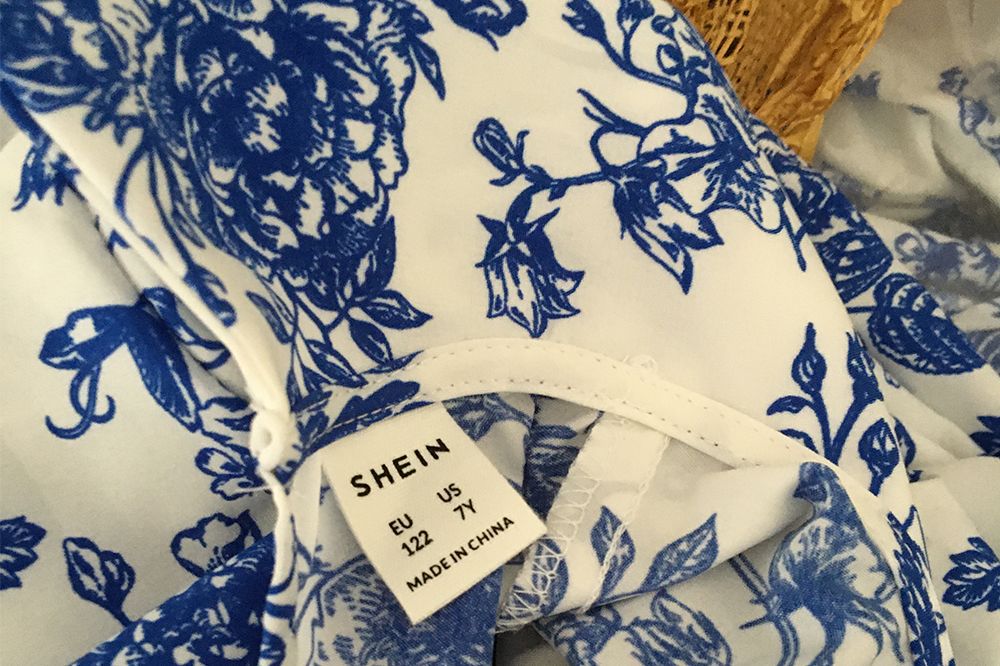
The dress that we had discovered in one of the factories in Guangzhou…
It would have been different if I lived in Germany. I know this because my colleague David Hachfeld also ordered the dress to his address there. He also wanted to send it back – but Shein did not want him to. “Today is your lucky day!”, he was told. “Please keep the item at our expense.” He was reimbursed the full purchase price. The reason the returns were handled differently is that, in Germany, Shein advertises “free returns” and would have therefore been obliged to take on the postage costs for the return itself – which clearly isn’t worth it for a dress that costs EUR 10.
“You can see that things had to be done quickly”
Now that we won’t be sending the item back, we at least want to know what we’ve got, by consulting experts. In the IDM sewing training centre in Thun we hear what aspiring fashion creators think about the quality of the dress. We cover up the Shein label in an attempt to get an unbiased assessment. The results are not positive.
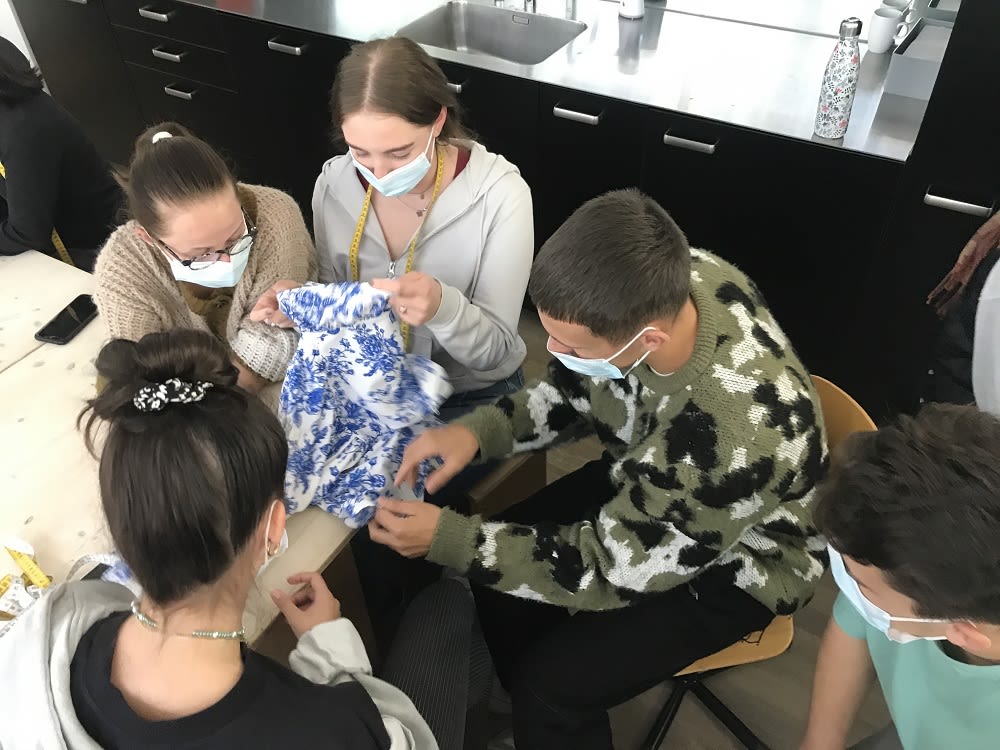
…was inspected by aspiring fashion designers at the IDM sewing factory in Thun.
“Oops – the fabric hasn’t been stitched properly there” notices one student when inspecting the seam. “It shouldn’t be so wrinkled around the seams– it wasn’t ironed”, notes one of her classmates. Further points of criticism include: “the yarn tension is poor”, “the stitching isn’t even”, and “these threads should have been cut.”
The final conclusion of one of the students: “You can see that things had to be done quickly.”
We also show the dress, together with a few other Shein items of clothing, to the teachers. Their assessment is not so negative. The production is better in some cases and worse in others, but overall it’s more or less average for fast fashion. However, they say that some of the fabric is so cheap that you would probably struggle to sell it to a customer in a shop.

The dress that we had discovered in one of the factories in Guangzhou…
The dress that we had discovered in one of the factories in Guangzhou…

…was inspected by aspiring fashion designers at the IDM sewing factory in Thun.
…was inspected by aspiring fashion designers at the IDM sewing factory in Thun.
The conclusion
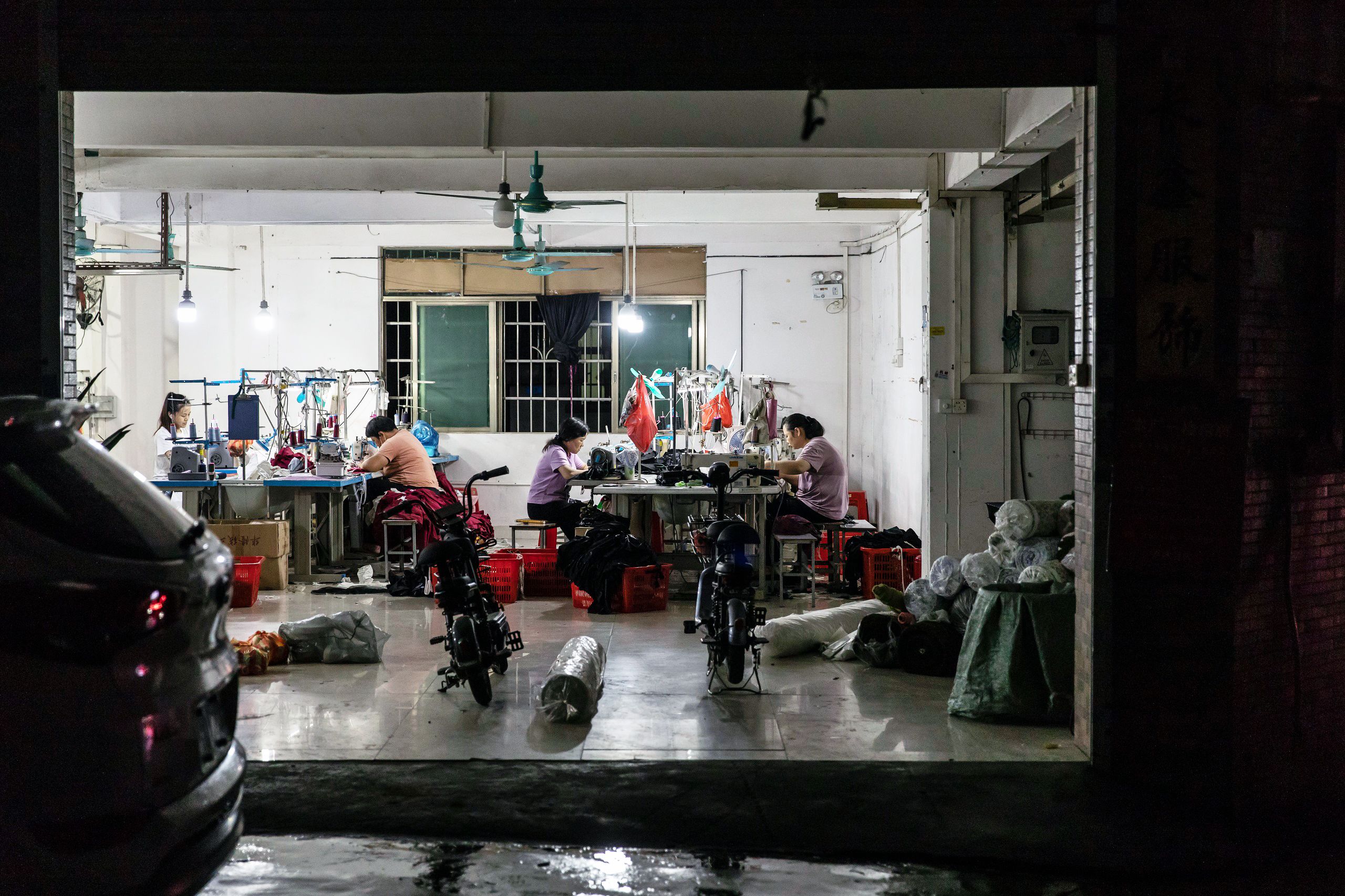
For the final leg of our journey, we return eastward – around 9,000 kilometres– from the small town of Thun to the mega-city of Guangzhou, and try to draw some conclusions. Anyone who had expected ultra-low wages in the light of the prices of Shein clothing would at first glance be astounded: you can earn quite good money producing clothes for Shein. Incomes are significantly above the monthly living wage of 5,410 yuan, as calculated by the Asia Floor Wage Alliance, a group of unions and civil society organizations from the Global South.
However, the comparison is fundamentally flawed, because all ten workers who we spoke to effectively work two jobs in one.
They work 11, 12, sometimes 13 hours a day, mostly 7 days a week, with no premium for overtime.
Shein systematically takes advantage of the fact that these employees are prepared to forgo even a minimum degree of safety, free time and quality of life, because they feel that they don’t really have an alternative.
None of those interviewed could show an employment contract. According to our information, no social security contributions are being paid for any of them, and many companies fail to comply with even the most basic safety standards.
These are all violations of Chinese law.
In its Supplier Code of Conduct, Shein requires its subcontractors to “operate in full compliance with local laws, rules, governmental orders and regulatory requirements”.
As we confront Shein with our findings, we immediately receive an automatic confirmation: “The Shein Sustainability Team has received your suggestions and feedback, and we will follow up on related matters as soon as possible. Thank you.” In response to a reminder sent a few days later, we receive the same computer-generated message once again. We don’t know whether our mail was ever read by a person.
After editors of major media outlets confronted Shein with the results of our research, someone contacted us the day before publication: the Vice President for U.S. Public Affairs at “Shein Technology”. We forwarded our questions to him and received a short message a few hours later: “SHEIN has no comment at this time as we await a copy of the report and an opportunity to review. We take all supply chain matters seriously and look forward to hearing back.”
What does it say on a hoodie that’s for sale in six different colours for CHF 9 on Shein’s website? “Fun fact: I don’t care.”

“Fun Fact: I don’t care” – the wording on this hoodie seems to describe the company’s business ethos quite accurately.
“Fun Fact: I don’t care” – the wording on this hoodie seems to describe the company’s business ethos quite accurately.
Focus on Global Justice
Public Eye campaigns to ensure that Switzerland, as well as Swiss companies, live up to their responsibility to respect human rights worldwide. Reports like this one are only possible thanks to the people who support us. Make a donation.
Impressum
Research: David Hachfeld, Timo Kollbrunner
Pictures: Panos Pictures
Thanks
We would like to thank the workers and trade unionists who provided us with information, the researchers on site, without whom we would not have found out anything about the working conditions in Panyu, Aparna Roy for her accurate preliminary research, as well as Cédric Leterme and the achACT team for their support in Belgium.

